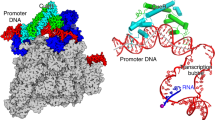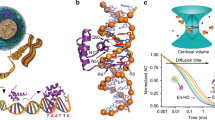Abstract
The short sequence motif named 'zinc finger', first recognized repeated in tandem in the Xenopus transcription factor IIIA (TFIIIA)1,2, is also found in the yeast transcriptional activator SWI5 (ref. 3) and many other regulator proteins4. Embedded in the 709-amino-acid polypeptide chain of SWI5 are three tandemly repeated zinc-finger motifs. Because the zinc fingers of TFIIIA are known to bind to DNA, it is probable that in the case of SWI5 these finger motifs also play an important, but not necessarily exclusive, role in the sequence-specific binding of the protein to DNA. To test this prediction we have expressed the 89-amino-acid sequence of the domain containing the three zinc fingers of SWI5 in Escherichia coli as a cleavable fusion protein, purified under denaturing conditions and folded in vitro. This experimental approach allows us to study directly both the metal requirement and DNA-binding properties of the isolated polypeptide. We find that zinc is required for specific DNA recognition and, most significantly, DNaseI protection studies show that the isolated three-fingered domain is sufficient for sequence-specific binding to DNA.
This is a preview of subscription content, access via your institution
Access options
Subscribe to this journal
Receive 51 print issues and online access
$199.00 per year
only $3.90 per issue
Buy this article
- Purchase on Springer Link
- Instant access to full article PDF
Prices may be subject to local taxes which are calculated during checkout
Similar content being viewed by others
References
Miller, J., McLachlan, A. D. & Klug, A. EMBO J. 4, 1604–1614 (1985).
Brown, R. S., Sander, C. & Argos, P. FEBS Lett. 186, 271–274 (1985).
Stillman, D. J., Bankier, A., Seddon, A., Gorehout, G. & Nasmyth, K. A. EMBO J. 2, 485–494 (1988).
Klug, A. & Rhodes, D. Trends biochem. Sci. 12, 464–469 (1987).
Stern, M., Jensen, R. & Herskowitz, I. J. molec. Biol. 178, 853–868 (1984).
Nasmyth, K., Seddon, A. & Ammerer, G. Cell 49, 549–558 (1987).
Diakun, G. P., Fairall, L. & Klug, A. Nature 324, 689–691 (1986).
Tso, T. Y., Van Den Berg, D. J. & Korn, L. J. Nucleic Acids Res. 14, 2187–2200 (1986).
Frankel, A. D., Berg, J. M. & Pabo, C. O. Proc. natn. Acad. Sci. U.S.A. 84, 4841–4845 (1987).
Nagai, K. & Thögersen, H. C. Meth. Enzym. 143, 461–481 (1987).
Hanas, J. S., Hazuda, D. J., Bogenhagen, D. F., Wu, F. Y. H. & Wu, C. W. J. biol. Chem. 258, 14120–14125 (1983).
Rhodes, D. & Klug, A. Cell 46, 123–132 (1986).
Hartshorne, T. A., Blumberg, H. & Young, E. T. Nature 320, 283–287 (1986).
Author information
Authors and Affiliations
Rights and permissions
About this article
Cite this article
Nagai, K., Nakaseko, Y., Nasmyth, K. et al. Zinc-finger motifs expressed in E. coli and folded in vitro direct specific binding to DNA. Nature 332, 284–286 (1988). https://doi.org/10.1038/332284a0
Received:
Accepted:
Issue Date:
DOI: https://doi.org/10.1038/332284a0
This article is cited by
-
A novel X-linked member of the human zinc finger protein gene family: isolation, mapping, and expression
Mammalian Genome (1993)
-
Early aspects of Caenorhabditis elegans sex determination and dosage compensation are regulated by a zinc-finger protein
Nature (1991)
-
A regulatory hierarchy for cell specialization in yeast
Nature (1989)
-
Altering DNA-binding specificity of GAL4 requires sequences adjacent to the zinc finger
Nature (1989)
Comments
By submitting a comment you agree to abide by our Terms and Community Guidelines. If you find something abusive or that does not comply with our terms or guidelines please flag it as inappropriate.



